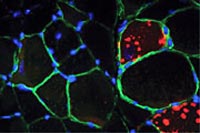Uncleaned Cells Mean Weak Muscles

Muscle fibers in mice with hyperactive mTORC1 (Red: accumulated waste). Image: University of Basel <br>
Similarly to parts in a machine, individual components of a cell wear out with time. For a cell to remain healthy, malfunctioning components and waste products must be regularly disposed of or recycled. A cellular self-cleaning process, called autophagy, is responsible for this.
However, the capacity for self-renewal decreases with age and participates in a wide range of age-related diseases such as cancer, heart disease and muscle weakness. In this process, the growth regulator, mTORC1, plays a primary role. The exact relationship has now been discovered by Markus Rüegg’s team from the Biozentrum of the University of Basel, together with scientists from the Department of Biomedicine.
Muscle weakness due to overactive growth regulator
Until recently, it was assumed that the protein complex mTORC1 in the skeletal muscle plays a key role in growth regulation but not in the process of autophagy. Rüegg and his team of scientists have been able to refute this widely accepted assumption. In the current study, they investigated the cellular processes in skeletal muscle of mice, in which mTORC1 was permanently activated. Particularly in aging mice, the scientists observed a progressive myopathy, which could be ascribed to impaired autophagy. Interestingly, the researchers could reverse the symptoms by administering rapamycin. The muscle function of the mice returned to normal. Rapamycin is a substance that inhibits mTORC1, thereby promoting cell self-cleaning.
Counteracting muscle breakdown
According to these findings, mTORC1 plays a major role in tightly coordinating the mechanism of autophagy, maintaining the balance between muscle growth and breakdown. The scientists suspect that an overactive mTORC1 complex may also contribute to the development of the age-related muscle weakness seen in man. Therefore, a closer examination of the mTORC1 regulation system in the context of aging may provide new therapeutic approaches for the counteracting of the muscle weakness.
Original article
Perrine Castets, Shuo Lin, Nathalie Rion, Sabrina Di Fulvio, Klaas Romanino, Maitea Guridi, Stephan Frank, Lionel A. Tintignac, Michael Sinnreich and Markus A. Rüegg (2013)
Sustained activation of mTORC1 in skeletal muscle inhibits constitutive and starvation-induced autophagy and causes a severe, late-onset myopathy
Cell Metabolism; Published online April 18, 2013
Further Information
Prof. Dr. Markus Rüegg, University of Basel, Biozentrum, Klingelbergstrasse 50/70, 4056 Basel, Switzerland, Phone: +41 61 267 22 23, Email: markus-a.ruegg@unibas.ch
Media Contact
All latest news from the category: Life Sciences and Chemistry
Articles and reports from the Life Sciences and chemistry area deal with applied and basic research into modern biology, chemistry and human medicine.
Valuable information can be found on a range of life sciences fields including bacteriology, biochemistry, bionics, bioinformatics, biophysics, biotechnology, genetics, geobotany, human biology, marine biology, microbiology, molecular biology, cellular biology, zoology, bioinorganic chemistry, microchemistry and environmental chemistry.
Newest articles

Redefining Cancer Science: Rodents, Humans, and the PD-1 Puzzle
Results of a comprehensive analysis refute assumptions that a key immune checkpoint receptor functions the same in rodents and humans The Discovery of PD-1: A Milestone in Cancer Treatment Since…

Heart Surgery Risks: Low BP Linked to Postoperative Kidney Injury
First large cohort study at the Heart and Diabetes Center NRW awarded – Hilke Jung presents research project at the FoRUM conference of the Ruhr University Bochum A working group…

Microbial Secrets: Boost Plant Growth with the Power of Soil Bacteria
To stay healthy, plants balance the energy they put into growing with the amount they use to defend against harmful bacteria. The mechanisms behind this equilibrium have largely remained mysterious….



